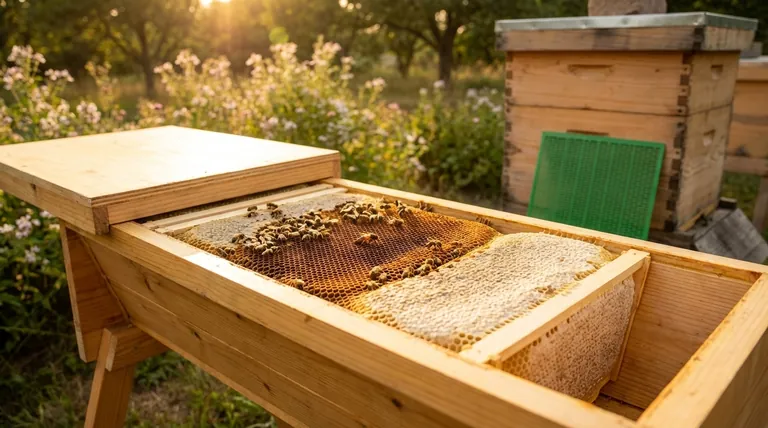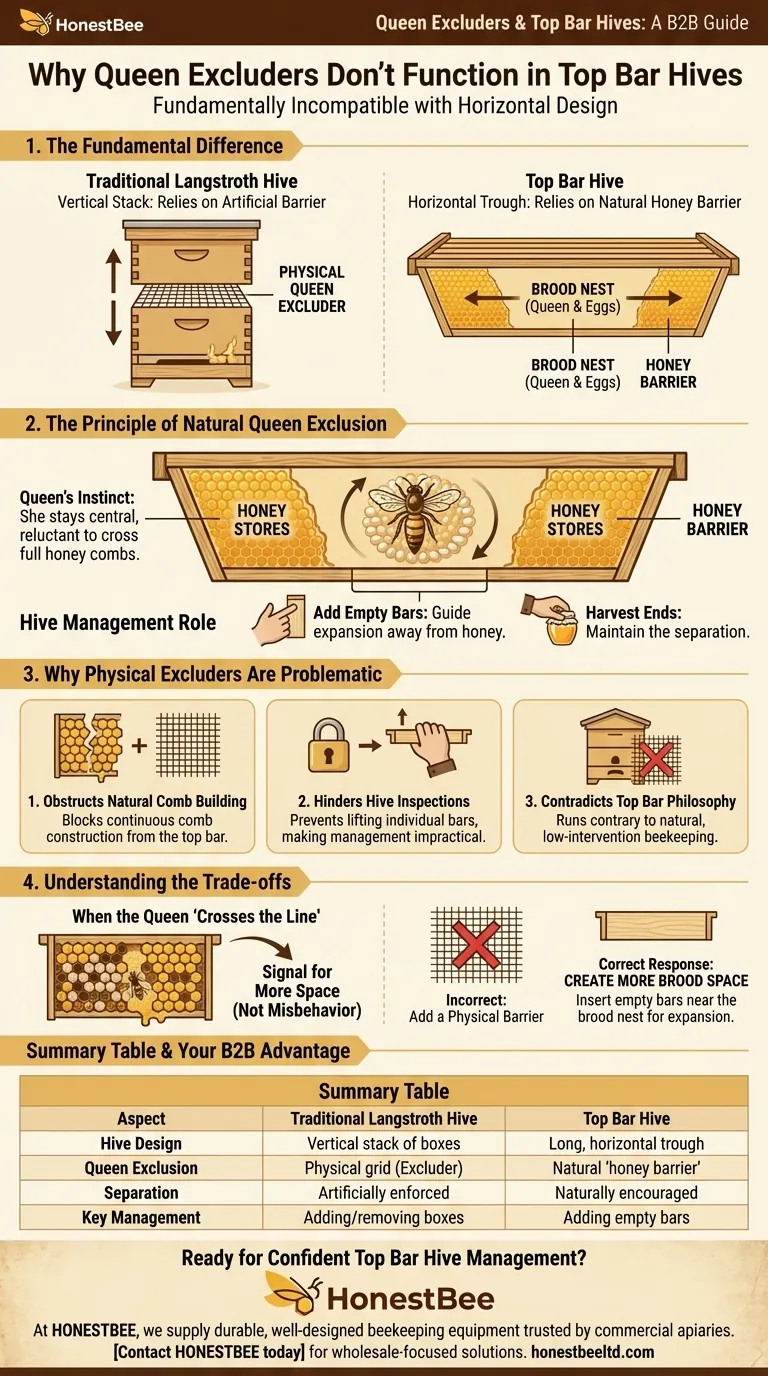In short, they generally don't. Queen excluders are a tool for vertically stacked hives and are fundamentally incompatible with the design and management philosophy of a horizontal top bar hive. Instead, top bar hives rely on the bees' natural behavior and the hive's layout to create a "natural queen exclusion," separating the brood nest from honey stores without a physical barrier.
The core principle is that a top bar hive's horizontal design encourages bees to build a central brood nest and store honey on the outer combs. This creates a natural "honey barrier" that the queen is reluctant to cross, making a physical excluder unnecessary and impractical.

The Principle of Natural Queen Exclusion
To understand why excluders aren't used, you first need to understand the structural difference between hive types. A traditional Langstroth hive is a vertical stack of boxes, while a top bar hive is a long, horizontal trough. This difference is critical.
The Brood Nest's Natural Shape
The queen bee's instinct is to lay eggs in a concentrated, contiguous pattern, forming a sphere or oval-shaped "brood nest." In a horizontal top bar hive, she establishes this nest in the center of the available space.
The "Honey Barrier"
As the colony expands, worker bees begin storing honey. They instinctively place this honey in the combs adjacent to the brood nest, effectively creating a wall or barrier of honey on either side of it.
The queen is biologically driven to stay within the brood area and will not typically travel across several full combs of honey just to lay a few eggs on the other side. This behavioral tendency is the foundation of natural queen exclusion.
The Role of Hive Management
The beekeeper manages this natural separation. By adding empty bars to the back of the hive, you encourage honey storage away from the brood nest. By harvesting full honey combs from the ends, you maintain this separation.
Why a Physical Excluder is Problematic in a Top Bar Hive
Attempting to force a traditional queen excluder into a top bar hive would create more problems than it solves.
It Obstructs Natural Comb Building
Bees in a top bar hive build their comb down from a single top bar. The comb is continuous and fragile. A vertical grid placed inside the hive would physically block this natural construction and likely be fused to the comb with propolis and wax, making it impossible to remove without destroying the comb.
It Hinders Hive Inspections
Managing a top bar hive involves lifting individual bars one by one. A rigid excluder would prevent this entirely, making routine inspections and hive management impractical.
It Contradicts Top Bar Philosophy
Many beekeepers choose top bar hives for a more natural, less-interventive style of beekeeping. Adding artificial internal barriers like an excluder runs contrary to this entire approach.
Understanding the Trade-offs: When the Queen "Crosses the Line"
Occasionally, you will find brood mixed in with honey combs. This is not a failure but a form of communication from the colony.
A Signal for More Space
If the queen begins laying in combs you designated for honey, it's almost always a sign that the colony feels crowded. She is not "misbehaving"; she is desperately trying to find more space to expand the brood nest to grow the colony's population.
The Correct Response
The solution is not to add a barrier. The proper response is to create more space for brood. This is done by inserting empty top bars between the brood nest and the honey stores, giving the queen room to expand the nest in the direction you prefer. This manages the colony's needs while preserving the separation of honey and brood.
Applying This to Your Hive
Your management strategy should be guided by the colony's behavior, not by forcing a separation that the hive's design already encourages.
- If your primary focus is pure honey harvesting: Consistently harvest the honey-only combs from the ends of the hive, furthest from the central brood nest.
- If your primary focus is colony growth and strength: Interpret brood in the honey stores as a signal to add more empty bars near the brood nest to allow for healthy expansion.
- If your primary focus is a low-intervention approach: Trust the bees. Their natural instincts to separate brood and honey are the most effective management tool in a top bar hive.
By understanding the bees' natural tendencies, you can manage a top bar hive effectively without ever needing a queen excluder.
Summary Table:
| Aspect | Traditional Langstroth Hive | Top Bar Hive |
|---|---|---|
| Hive Design | Vertical stack of boxes | Long, horizontal trough |
| Queen Exclusion Method | Physical wire/plastic grid (Queen Excluder) | Natural "honey barrier" created by bees |
| Brood/Honey Separation | Artificially enforced by the excluder | Naturally encouraged by the hive's layout |
| Key Management Action | Adding/removing boxes | Adding empty bars to guide expansion |
Ready to manage your top bar hive with confidence and efficiency?
At HONESTBEE, we supply the durable, well-designed beekeeping supplies and equipment that commercial apiaries and distributors trust. Whether you're expanding your operation or need reliable tools for natural hive management, our wholesale-focused solutions are built to support your success.
Contact HONESTBEE today to discuss your equipment needs and discover the HONESTBEE advantage!
Visual Guide

Related Products
- High Performance Plastic Queen Excluder for Beekeeping and Apiary Management
- Professional Plastic Queen Excluder for Modern Beekeeping
- Wooden Queen Bee Excluder for Beekeeping
- Premium Wood Framed Metal Wire Queen Bee Excluder
- Plastic Queen Bee Excluder for Bee Hive Wholesale
People Also Ask
- When is the best time to place a queen excluder? Optimize Honey Production & Purity
- When is the typical time frame for harvesting honey and removing the queen excluder? Optimize Your Hive Management
- Why don't all beekeepers use Queen Excluders? Balancing Honey Purity with Hive Productivity
- What happens if I don't use a queen excluder? Understand the impact on your honey harvest.
- What is a queen excluder, and how does it function? A Guide to Hive Management



















